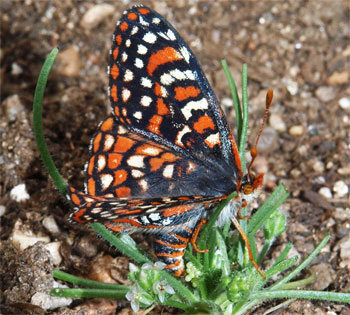
Think Globally, But Act Locally When Studying Plants, Animals, and Global Warming, Researchers Advise
Global warming is clearly impacting plants and animals, but we should not try to tease apart the specific contribution of greenhouse gas-driven climate change to declines or extinctions of species at local scales, according to biologists working with UC Santa Barbara's National Center for Ecological Analysis and Synthesis (NCEAS).
Camille Parmesan, associate professor of biology at the University of Texas at Austin, and Michael C. Singer, professor of biology, also at UT, and their co-authors published their commentary article in the inaugural issue of the journal Nature Climate Change this week. The authors participated in a working group through NCEAS, a leading ecology center that brings together scientists from research institutions worldwide.
"Yes, global warming is happening," said Parmesan. "Yes, it is caused by human activities. And yes, we've clearly shown that, on a global scale, species are impacted by global warming." Parmesan spent three years as a postdoctoral fellow at NCEAS in the late 1990's, working on her well-known Edith's checkerspot butterfly studies.
In this new article, the scientists argue that human-induced changes of the climate are detectable on large spatial scales, while individual organisms experience only local climate.
"From the perspective of a wild plant or animal," they write, "a changing climate is a changing climate, irrespective of its cause."
The scientists also argue that, at a local scale, any particular population of plants and animals is affected by all kinds of human activities. Air pollution, invasive species, sprawling urban areas and agricultural fields all make survival very hard for much of wildlife.
"Effects of climate change are everywhere, but they act on top of all these other stresses faced by wild species," said Parmesan. "Humans are impacting species in very complex ways."
For example, the scientists cited the Quino checkerspot butterfly in Southern California. The butterfly became endangered in the 1980's, principally because of the growth of Los Angeles and San Diego. Less than six populations of the butterfly remain in the United States, and they suffer from a complex of factors. A warming and drying climate is shortening the life of host plants, causing caterpillars to starve. The plants themselves are suffering from competition with introduced Mediterranean geraniums, likely encouraged by nutrients in rain falling through polluted air.
"All of these things have been happening, so when we see one of these populations wink out, we suspect them all," said Singer, who has been working on this species since the 1960's. "Climate change is definitely part of the context for this butterfly in this system, but it isn't the only driver."
Policymakers have recently been pressing biologists to produce analyses that dissect how many of the changes observed in species are due specifically to greenhouse gas-driven climate change versus other possible factors, including natural changes in the climate.
"There has been an expectation that biologists can and should do this, perhaps because we helped so much with detection of warming trends themselves by showing that wild plants and animals have changed when they are active and where they live, but this is different," said Parmesan, who has worked with conservation practitioners such as the U.S. Fish and Wildlife Service as they struggle to cope with and anticipate the effects of climate change.
Research funding is limited, and the scientists feel that it should be directed more toward studies on species adaptations and conserving compromised species, rather than figuring exactly what percent of a species' decline is due to rising greenhouse gases.
"Is anthropogenic climate change affecting species?" asked Parmesan. "Yes, it is. What we need to do now is to focus on extensive field experiments and observations that try to understand how multiple factors, such as exploitation or habitat fragmentation, interact with a changing climate to directly affect these species."
For conservation biologists and policymakers, it's those driving forces that are most critical to understand, and that can lead to appropriate, and sometimes immediate, interventions.
"Conservation is going to have to happen locally," says Parmesan. "As a park manager, you can't do a thing about anthropogenic climate change. But these other stressors, such as habitat loss and pollution, are things we can do something about.
"Think globally about climate change and how that's going to affect your national park, or your reserve, or your endangered species," she said. "But in terms of action, you've got to think locally about what you need to do in terms of habitat restoration, removing invasive species, assisting species migration, etcetera. Those are things you can do something about."
Parmesan shares a Nobel Prize with the authors of the International Panel on Climate Change for their Third Assessment Report.
Related Links
National Center for Ecological Analysis and Synthesis
Nature Climate Change Journal



